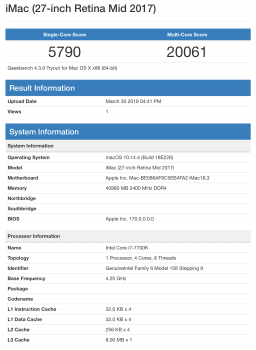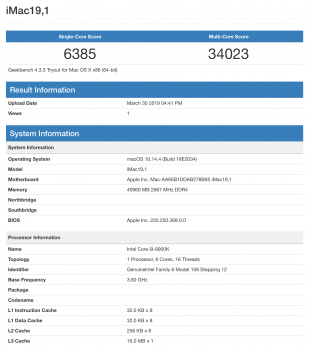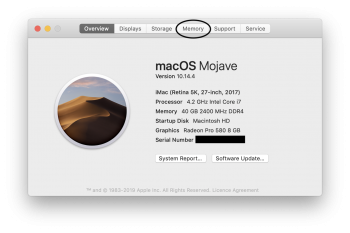After a day or two of intensive research, I earlier today ordered:
iMac (Retina 5K, 27-inch, Early 2019)
Commentary:
This iMac will replace my iMac (Retina 5K, 27-inch, Late 2015) with 4 GHz Intel Core i7, Radeon R9 M395X, and 3 TB Fusion Drive.
CPU: Benchmarks are starting to pop up on the Web showing that this new iMac maintains a consistent 3.8 to 3.9 GHz under heavy and sustained load with all cores maxed out while remaining quiet. Note that this exceeds the advertised base clock speed. With six of the eight cores maxed out, it appears to maintain a consistent 4.7 GHz under sustained load.
This is far better than many feared would be the case, given the unchanged thermal design of the iMac itself, and suggests that the new thermal design of the Core i9, when restricted to 95W (as it clearly seems to be here), is working quite well.
RAM: I’ll upgrade this myself, probably to 40 GB. (Given that one can buy a pair of 16 GB DIMMs, bringing the base 8 GB up to 40 GB, for the same US $200 that Apple charges to upgrade from 8 GB to 16 GB, this seems to be a no-brainer.)
Graphics: I’ll be gaming on this iMac, and it looks like the Radeon Pro Vega 48 should be able to handle recent games in 1440p resolution at high-quality graphics settings (although perhaps not Ultra) without breaking much of a sweat. (Remember that the iMac’s display is locked to 60 fps, so we’re obviously not looking at ultra-high-framerate gaming here.)
(For “serious” work, the extra compute power of the Radeon Pro Vega 48 should appeal to you pros. A search of the Geekbench 4 compute database shows OpenCL scores in the range of ~135,000 to ~151,000, compared to scores in the range of ~107,000 to ~127,000 for the Radeon Pro 580X. Metal scores are in the same ranges. This is, on average, a 22% increase in compute performance over the 580X.)
Importantly, all reports indicate that the HBM2 memory on the Vega GPUs generates substantially less heat than the GDDR5 memory on the Polaris GPUs (like the 580X), so despite being more powerful, the Vega 48 should either run cooler than the 580X, or if instead the two GPUs are allowed to run at the same temperature, the Vega 48 should have more room in its thermal budget for a higher GPU clock frequency (and thus for even higher performance).
With Thunderbolt 3, if I want even more GPU power or a higher-framerate display, I can always add an eGPU.
Storage: The largest SSD Apple offers is 2 TB, which is US $1,000 more expensive and 1 TB less storage, and 2 TB is simply not enough. In fact, I find 3 TB cramping as it is.
As supported by Apple, Boot Camp must go on an internal drive. I want room for Mac games and apps, Windows games, and a growing movie library. All of these take room.
I have a 3 TB Fusion Drive in my 2015 iMac, and I’ve been very happy with it. It has a 128 GB SSD (like the 2 TB, but unlike the 1 TB Fusion Drive, which has only a 32 GB SSD), which does the trick nicely. It’s lightning fast for almost everything I do with it.
(The Boot Camp partition lives entirely on the spinning hard drive. It does make booting into Windows slower, as well as loading games, but neither of these actually takes long - the iMac’s hard drive is very fast as hard drives go - and the games run just as fast as they would on an SSD. Since I use Windows only for gaming - and then almost only when I can’t play the same game in macOS - I can live with Windows on the spinning hard drive just fine.)
Timing: The Early 2019 iMacs will be the last iMacs released before the 32-bit apocalypse this September (aka macOS 10.15). With the continuing ability to boot into Mojave from an external drive even after the apocalypse and the ability to boot into Windows 10 via Boot Camp, I have every expectation that this will be a capable and versatile gaming computer that will continue to be able to run older software and play older games and, with the ability to add an eGPU via Thunderbolt 3, will continue to hold its own for at least a few years to come.
Vendor: I bought from Expercom via the link in this MacRumors story, which saved me $179 on top of the savings in sales tax, for a total savings of US ~$500. (Free shipping, too!) Thanks, MacRumors!
iMac (Retina 5K, 27-inch, Early 2019)
3.6 GHz 8-core Intel Core i9
8 GB RAM
Radeon Pro Vega 48
3 TB Fusion Drive
8 GB RAM
Radeon Pro Vega 48
3 TB Fusion Drive
Commentary:
This iMac will replace my iMac (Retina 5K, 27-inch, Late 2015) with 4 GHz Intel Core i7, Radeon R9 M395X, and 3 TB Fusion Drive.
CPU: Benchmarks are starting to pop up on the Web showing that this new iMac maintains a consistent 3.8 to 3.9 GHz under heavy and sustained load with all cores maxed out while remaining quiet. Note that this exceeds the advertised base clock speed. With six of the eight cores maxed out, it appears to maintain a consistent 4.7 GHz under sustained load.
This is far better than many feared would be the case, given the unchanged thermal design of the iMac itself, and suggests that the new thermal design of the Core i9, when restricted to 95W (as it clearly seems to be here), is working quite well.
RAM: I’ll upgrade this myself, probably to 40 GB. (Given that one can buy a pair of 16 GB DIMMs, bringing the base 8 GB up to 40 GB, for the same US $200 that Apple charges to upgrade from 8 GB to 16 GB, this seems to be a no-brainer.)
Graphics: I’ll be gaming on this iMac, and it looks like the Radeon Pro Vega 48 should be able to handle recent games in 1440p resolution at high-quality graphics settings (although perhaps not Ultra) without breaking much of a sweat. (Remember that the iMac’s display is locked to 60 fps, so we’re obviously not looking at ultra-high-framerate gaming here.)
(For “serious” work, the extra compute power of the Radeon Pro Vega 48 should appeal to you pros. A search of the Geekbench 4 compute database shows OpenCL scores in the range of ~135,000 to ~151,000, compared to scores in the range of ~107,000 to ~127,000 for the Radeon Pro 580X. Metal scores are in the same ranges. This is, on average, a 22% increase in compute performance over the 580X.)
Importantly, all reports indicate that the HBM2 memory on the Vega GPUs generates substantially less heat than the GDDR5 memory on the Polaris GPUs (like the 580X), so despite being more powerful, the Vega 48 should either run cooler than the 580X, or if instead the two GPUs are allowed to run at the same temperature, the Vega 48 should have more room in its thermal budget for a higher GPU clock frequency (and thus for even higher performance).
With Thunderbolt 3, if I want even more GPU power or a higher-framerate display, I can always add an eGPU.
Storage: The largest SSD Apple offers is 2 TB, which is US $1,000 more expensive and 1 TB less storage, and 2 TB is simply not enough. In fact, I find 3 TB cramping as it is.
As supported by Apple, Boot Camp must go on an internal drive. I want room for Mac games and apps, Windows games, and a growing movie library. All of these take room.
I have a 3 TB Fusion Drive in my 2015 iMac, and I’ve been very happy with it. It has a 128 GB SSD (like the 2 TB, but unlike the 1 TB Fusion Drive, which has only a 32 GB SSD), which does the trick nicely. It’s lightning fast for almost everything I do with it.
(The Boot Camp partition lives entirely on the spinning hard drive. It does make booting into Windows slower, as well as loading games, but neither of these actually takes long - the iMac’s hard drive is very fast as hard drives go - and the games run just as fast as they would on an SSD. Since I use Windows only for gaming - and then almost only when I can’t play the same game in macOS - I can live with Windows on the spinning hard drive just fine.)
Timing: The Early 2019 iMacs will be the last iMacs released before the 32-bit apocalypse this September (aka macOS 10.15). With the continuing ability to boot into Mojave from an external drive even after the apocalypse and the ability to boot into Windows 10 via Boot Camp, I have every expectation that this will be a capable and versatile gaming computer that will continue to be able to run older software and play older games and, with the ability to add an eGPU via Thunderbolt 3, will continue to hold its own for at least a few years to come.
Vendor: I bought from Expercom via the link in this MacRumors story, which saved me $179 on top of the savings in sales tax, for a total savings of US ~$500. (Free shipping, too!) Thanks, MacRumors!
Last edited:





